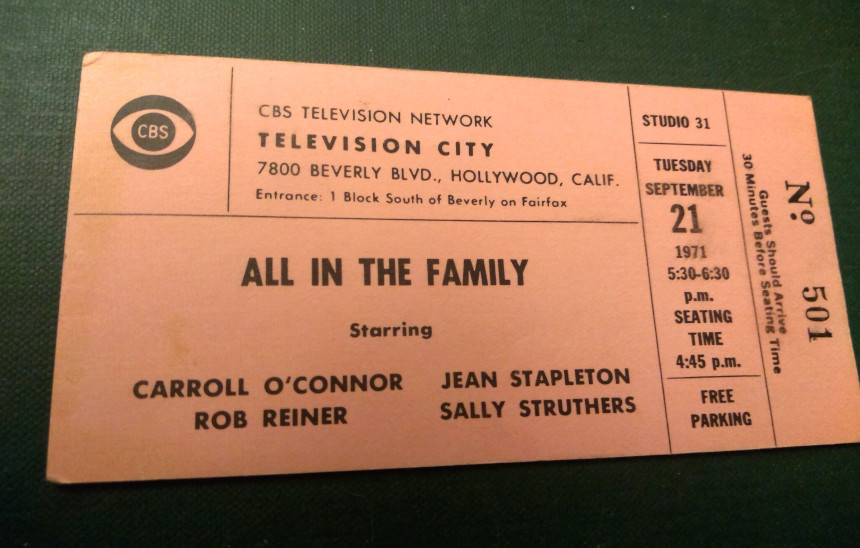Fifty years ago, the big three networks of CBS, NBC, and ABC ruled the TV landscape. With cable and other pay channels still years away, they were, in many places, the only game in town. Families settled in for shows like Lassie or The High Chaparral. That is, until 1971, when a convergence of events upended what the networks offered and which audiences they pursued. The year would mark the beginning of a permanent shift in the kind of shows we watched and how we watched them. This is how it happened.
The shape of TV changed 50 years ago in a number of ways. First, a shift in FCC rules took an hour away from the networks and gave it to local stations; this led to a several programs jumping from the network to a new life in syndication. One of those programs was Lassie. Music would also boom in syndication, as two network refugees (Hee Haw, The Lawrence Welk Show) found a new home alongside a syndicated original (Soul Train), after which all three shows ran for many more years. A different side effect of that lost hour of prime time was the cancellation of a number of other long-running programs, many of which were on CBS and many of which featured rural or small-town settings. Nicknamed “The Rural Purge,” this move demonstrated a philosophical sea change in how the networks and advertisers were targeting the audience.
The first episode of CSI: Crime Scene Investigation (Uploaded to YouTube by CSI/CBS)
Today, you might associate CBS most with procedurals (that is, cop or investigation shows), sitcoms, and reality competition programs. Shows like CSI: Crime Scene Investigation and Survivor became ratings juggernauts and inspired their own waves of programming. A similar programming outgrowth had started on the network in the 1950s; when rural themed programming proved popular with viewers, the network went all in, building out a number of sitcoms and shows all themed around small-town or country settings.
Season 1 of The Beverly Hillbillies (Uploaded to YouTube by Classic Comedy Channel)
By 1971, some of those shows had been on the air for many years, but were still doing decently in the ratings. Among those programs were The Andy Griffith Show spin-off Mayberry R.F.D., The Beverly Hillbillies, and Green Acres. Lassie was a drama, but had a similar setting, and country music variety show Hee Haw courted a similar audience. When prime-time lost an hour due to the FCC ruling, CBS execs decided to axe those five shows. Gunsmoke almost went, too, but a ratings resurgence earlier that season kept it on the air a few more years. Instead, Family Affair, Hogan’s Heroes, The Johnny Cash Show, and The Ed Sullivan Show got dropped.
The major rationale for excising these shows was that they appealed to demographics that were less desirable to more lucrative advertisers. Younger audiences gravitated to newer CBS programs like The Mary Tyler Moore Show and All in the Family; the sitcoms were attracting big audiences while generating lots of discussion and “free press” for their modern topicality. The plan worked for CBS, as the network had room in the next few years to add groundbreaking programming like M*A*S*H*, Maude, The Jeffersons, and One Day at a Time.
The High Chaparral (Uploaded to YouTube by The High Chaparral TV Show)
NBC also had two notable 1971 cancellations that fit into the “rural purge” notion. Western The Virginian (later renamed The Man from Shiloh) ended after nine seasons, and fellow oater The High Chaparral ended after four. ABC’s cancellations from that year didn’t fit into the “rural purge” idea at all; two big departures included supernatural daytime soap Dark Shadows (which had experienced a serious ratings drop in its fifth year) and That Girl. That Girl was an outlier, as the Marlo Thomas series had youth appeal; however, Thomas was ready to move on to other projects. Interestingly, while her character and her long-time term boyfriend got engaged in the final season, Thomas insisted that they never wed on the show. Her reasoning was that she wanted female viewers to know that marriage wasn’t the only or “final” option in the world.
The 1971 realignment worked in CBS’s favor. The network was tied with NBC in 1970-1971, but by the following season, All in the Family was the #1 show and CBS was the sole owner of the top network position. The network would dominate much of the decade. After falling behind to ABC in the late 1970s, it would resurge in 1979-1980, buoyed by it sitcoms and boosted by the popularity of Dallas (ironically, a show that combined both urban and rural sensibilities) and The Dukes of Hazzard (uh, very rural).
The shift to more “relevant” or occasionally “urban” programming could be felt across network TV. While ABC leaned into some comfort fare like Happy Days, it also centered that show’s big spin-off, Laverne & Shirley, on two working women. By mid-decade, more shows with female and diverse leads broke through. Even John Shaft (you’re damn right) made the transition from film to CBS television, with film actor Richard Roundtree bringing his popular character to a series of TV movies; while Roundtree wasn’t happy with how the character was toned down for television, it was a significant step for the TV of the time.
The Flash Extended Trailer for The CW (Uploaded to YouTube by CW)
Today’s network landscape is actually fairly similar across the board. Procedurals occupy a broad swath of programming at every network, containing law-enforcement, medical, and firefighting iterations at CBS, NBC, ABC, and Fox. Sitcoms remain present, and every network has a reality-competition franchise. The CW has gone all in on DC Comics-related content while also hosting a strong Archie presence (Riverdale and its spin-offs).
While networks ruled TV in the 1970s, today their standing is greatly diminished. Most outside-the-box programming has migrated to cable and various streaming services. The last time that the Emmy for Outstanding Drama Series went to a network show was for the fifth season of 24 in 2006; in terms of comedy, the networks haven’t claimed that Emmy since 2014 and Modern Family’s fifth win. The cultural conversation has certainly been stolen by cable and streaming, even in reality programming (Tiger King, we’re looking at you, even if we tried to avoid it). 1971 marked a definite turnover in the kind of shows that networks chose to run; in 2021, it looks like more viewers than ever are running from the networks.
Featured image: Bart Sherkow / Shutterstock.com
Become a Saturday Evening Post member and enjoy unlimited access. Subscribe now




Comments
I watch ZERO network shows now. They are cheaply made; reality shows that emphasize over-acting and over-dramatization, or absurdly stupid game shows. Even the news programs are full of false information or manipulated stories. I am so grateful for hundreds of other choices besides the watered down stuff that flows from the CBS/NBC/
ABC sewer pipes.
Part 11.
‘Dark Shadows’ did indeed experience a serious ratings drop in its fifth season. It’s last air date was 50 ago today, Friday April 2, 1971. Being a favorite of mine, it’s painful to say it should have ended at the beginning of ’71, and they had the perfect ending (with the ending) of what should have been the final storyline.
This was an experimental daytime drama ONLY possible in the Soaring ’60s, and the first year (pre-vampire) was supernatural-ish, but was… boring, and in danger of cancellation in early ’67, given 13 weeks to turn things around or that was it. Dan Curtis’ daughter suggested he put in “all the stuff he wanted to” and did! Vampires, a female doctor/mad scientist, time-travel, witches, warlocks, dream curses, actors playing various characters and so much more. So much packed into the show that 1968 was its peak year creatively, and couldn’t sustain it even though its “ratings peak” was in ’69, not long after a wonderful feature in The Saturday Evening Post!
The only good thing about ‘Happy Days’ was its spinoff, ‘Laverne and Shirley’, a far better show. The former went on about 6 years too long. Other spinoffs were excellent, such as Norman Lear’s ‘Maude’ and ‘The Jeffersons. Not a spinoff but brilliant was Lear’s ‘Sanford & Son’. I LOVE that show, especially the episodes with ‘Aunt Esther’. In the end my 3 favorite Lear shows are still ‘Maude’, ‘Sanford & Son’ and another off-the-beaten-track soap opera, ‘Mary Hartman, Mary Hartman’ of course, of course.
Part I.
This is a great sequel article to your syndication feature (link included here) last month. The ‘rural purge’ was unfortunate, but actually went back to the later ’60s with CBS execs embarrassed by such ‘old fashioned, country folks’ fare in THOSE tumultuous times. Little did they know those ‘rural shows’ would remain timeless, popular fare in the 21st century, while ‘All in the Family’ now seems far more dated overall due to the very topicality they sought, and is fraught with material completely ‘unallowable’ now.
Marlo Thomas was put in an awkward position in her final season of ‘That Girl’ in 1970-’71. She was put in the unenviable position of being compared to ‘The Mary Tyler Moore Show’ being ‘cutting edge’ and ‘That Girl’ being ‘old and frivolous’ by comparison; and her character not being a ‘career woman’ like Mary. The fact is she DID portray a single career woman also, but not in ‘a male-dominated profession’. She had unfair criticism leveled at her because of that, and not by her male fans.
Furthermore, Ms. Thomas was shrewd in NOT marrying her boyfriend in the final season for the reasons she gave. However, if she had, in a series finale, that would have been nice too. Ironically in the first season of ‘Rhoda’ (’74-’75) the series practically started OFF with her getting married, and it quickly degenerated into arguing, fighting and therapy. It’s a miracle it lasted for several years. ‘Rhoda’ was finally divorced by the beginning of the ’78-’79 season, and it becoming fun to watch again with her being single. Sadly It was cancelled that November.